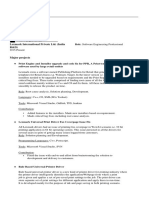0% found this document useful (0 votes)
58 views6 pagesHere Is A Complete Set of MySQL Notes
This document provides a comprehensive overview of MySQL, covering key concepts such as databases, tables, and queries. It includes basic SQL commands for database and table operations, data manipulation, select queries, aggregate functions, joins, constraints, advanced queries, indexes, views, stored procedures, and triggers. The notes serve as a practical guide for users to understand and utilize MySQL effectively.
Uploaded by
hemantmahto658Copyright
© © All Rights Reserved
We take content rights seriously. If you suspect this is your content, claim it here.
Available Formats
Download as DOCX, PDF, TXT or read online on Scribd
0% found this document useful (0 votes)
58 views6 pagesHere Is A Complete Set of MySQL Notes
This document provides a comprehensive overview of MySQL, covering key concepts such as databases, tables, and queries. It includes basic SQL commands for database and table operations, data manipulation, select queries, aggregate functions, joins, constraints, advanced queries, indexes, views, stored procedures, and triggers. The notes serve as a practical guide for users to understand and utilize MySQL effectively.
Uploaded by
hemantmahto658Copyright
© © All Rights Reserved
We take content rights seriously. If you suspect this is your content, claim it here.
Available Formats
Download as DOCX, PDF, TXT or read online on Scribd
/ 6























































































